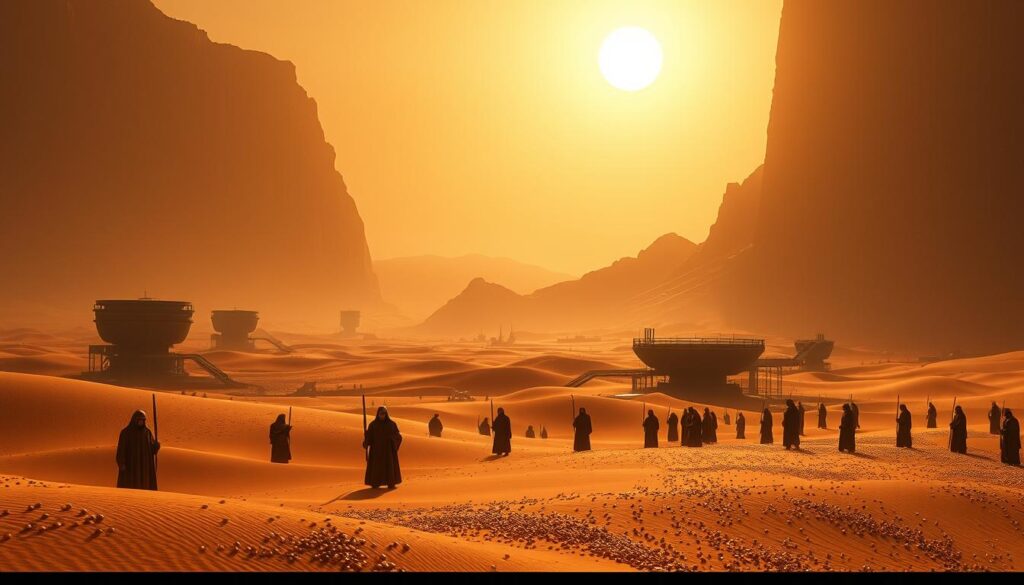We explore the fascinating world of melange from Frank Herbert’s Dune series, a substance that has captivated readers for decades. This rare and highly valuable spice is not only crucial for interstellar travel and commerce in the Dune universe but also plays a significant role in the series’ complex web of economics, politics, and ecology.
The significance of melange can be understood by drawing parallels with historical spices that have shaped human civilization. Just as spices like cinnamon and pepper were highly valued in our past, the spice in Dune is a literary device that connects various aspects of the fictional society. For more insights, you can visit Looper’s explanation on Dune Spice or learn more about the historical context at Historical Foods.
Key Takeaways
- The spice melange is a vital substance in the Dune universe, enabling space travel and commerce.
- It serves as a consciousness-expanding drug and a life-extending substance.
- The control of melange determines the center of power in the Empire.
- The spice has various uses, including cooking, medicine, and rituals.
- The Fremen culture heavily relies on the spice for their way of life.
- The galactic economy is driven by the spice trade.
What Is the Spice in Dune?
On the desert planet Arrakis, a rare and valuable resource known as melange is produced through an intricate ecological process. The spice melange is central to the economy and politics of the Dune universe, and its production is deeply intertwined with the planet’s unique ecosystem.
Origins and Production on Arrakis
The spice is created deep beneath the sands of Arrakis, where the fungal excretions of sandtrout mix with water to form a pre-spice mass. This mass is then brought to the surface through geological processes, where it is transformed into melange under the intense heat and air of the desert. The spice melange production is a complex process that involves the indigenous sandworms, massive creatures that both create and protect the spice.

The Sandworm Life Cycle
The sandworms, or Shai-Hulud, play a crucial role in the production of melange. Their life cycle begins as sandtrout, which excrete a substance that eventually becomes the pre-spice mass. As the sandworms grow and eventually die, they release sandtrout into the sand, perpetuating the cycle. This ecological cycle is unique to Arrakis and is the reason why melange can only be found on this desert planet.
| Stage | Description | Role in Spice Production |
|---|---|---|
| Sandtrout | Larval stage of sandworms | Excrete substance forming pre-spice mass |
| Sandworms | Massive creatures growing from sandtrout | Create and protect the spice |
| Pre-spice Mass | Mixture of sandtrout excretions and water | Precursor to melange spice |
The Properties and Effects of Melange
The melange, or spice, in Frank Herbert’s Dune universe has multifaceted properties that significantly impact those who consume it. As we explore the spice melange, we’ll examine its various effects on the human body and mind.
Physical Effects: The Blue Eyes of Ibad
One of the most noticeable effects of prolonged melange consumption is the discoloration of the eyes, resulting in the characteristic “Eyes of Ibad.” Sustained exposure to the spice leads to a permanent blue staining of the eyes, creating a distinctive monochrome appearance. This physical transformation is particularly evident among the Fremen and other heavy spice users.
Mental and Longevity Benefits
Melange consumption is also associated with significant mental and longevity benefits. The spice can awaken dormant parts of the human mind, enhancing sensory perception and, in some cases, granting prescient abilities. Regular consumption of melange can triple human life expectancy and fortify overall health, making it a highly valued substance. However, these benefits come with the risk of addiction, as the spice has narcotic properties that can lead to physical dependency.
- The spice melange affects both the mind and body of consumers.
- Prolonged exposure leads to the characteristic blue eye color.
- Melange enhances mental faculties and increases life expectancy.
Historical Spices That Inspired Frank Herbert
The spice melange, central to Frank Herbert’s Dune series, has roots in the real-world history of spice trade and cultural practices. Throughout the Dune Chronicles, melange is described as having an aroma similar to cinnamon, a spice that was once highly valued in global trade.
Cinnamon and the Spice Trade
Cinnamon was a highly prized commodity in ancient trade, controlled by a few desert kingdoms and trading powers. The value and rarity of cinnamon led to the establishment of extensive trade networks and sparked numerous conflicts. Frank Herbert, drawing from this history, created a fictional spice that is central to the political and economic dynamics of his Dune series. The historical spice trade’s impact on global economies and cultures likely inspired the intricate politics surrounding melange in the Dune novels.
Psychoactive Substances in Ancient Cultures
Frank Herbert’s depiction of melange’s consciousness-expanding properties may have been influenced by the use of psychoactive substances in ancient cultures. Substances like soma and ayahuasca were used in religious and shamanic practices to grant visions and special insights. Similarly, melange allows characters in the Dune series to access heightened states of awareness and prescience. By drawing on these historical practices, Herbert added depth and plausibility to his fictional universe, making melange a compelling and complex element of his novel series.
The Economic and Political Power of Spice
At the heart of the Dune series is the spice, a commodity so valuable that it has become the linchpin of interstellar politics and economy. The spice melange is the rarest and most valuablecommodityin the knownuniverse, making it a crucial element in the power dynamics between various factions.
Control and Leverage
We examine how controlling the spice production and distribution forms the economic backbone of the Dune universe, creating power dynamics that mirror historical commodity monopolies in our world. The famous quote “He who controls the spice controls the universe” highlights the immense political leverage granted by this fictional substance.
The economics of spice mining on Arrakis is fraught with danger, yet the immense value of even small quantities makes it a highly sought-after commodity. A briefcase full of spice could purchase an entire planet, illustrating its value in the interstellar economy.
| Aspect | Dune Universe | Real-World Parallels |
|---|---|---|
| Commodity Value | Spice melange | Rare spices, precious metals |
| Economic Impact | Controls interstellar economy | Influences global trade |
| Political Leverage | Dictates power dynamics | Shapes colonial and imperial strategies |
Historical Parallels
We draw historical parallels to real-world spice wars and commodity conflicts, such as the Dutch-Portuguese wars over nutmeg, highlighting how Herbert crafted a believable economic system based on historical precedents. The monopolistic control of vital resources like spice creates not just wealth but political power, much like colonial powers used control of spice-producing regions as part of their imperial strategies.
The Cultural Significance of Spice in Dune
The spice in Dune permeates every facet of the society, from daily rituals to spiritual practices, especially among the native Fremen. This substance not only shapes their daily lives but also influences their cultural and religious practices.
Fremen Rituals and Daily Use
The Fremen people incorporate spice into their daily use of food and inhale trace amounts, leading to “spice eyes” – a bright blue coloration. This change signifies their dependence on melange. The Fremen culture is deeply tied to the spice, creating a unique identity.
The Bene Gesserit and the Water of Life
The Bene Gesserit sisterhood uses the Water of Life, a concentrated form of spice, derived from a young sandworm. This ritual is transformative, enhancing their prescience abilities. The Water of Life is central to their spiritual practices, showcasing the diverse cultural significance of spice in different people‘s life.
Spice as Interstellar Travel Enabler
Interstellar travel in the Dune universe relies heavily on the rare and potent substance known as melange, or spice. The Spacing Guild, a powerful organization in the Dune series, depends on spice to navigate the vast distances between stars, making it a crucial element in the functioning of galactic civilization.
Guild Navigators and Prescience
Guild Navigators consume massive quantities of spice, which physically transforms their bodies and grants them prescient abilities. This allows them to safely guide ships through folded space, a necessity for faster-than-light travel. The unique properties of spice make it possible for Navigators to perform complex calculations that would otherwise require advanced computers, which are forbidden in the Dune universe following the Butlerian Jihad.
Historical Navigation Aids and Stimulants
Historically, explorers have used various aids and stimulants to enhance their navigational abilities. From astrolabes and sextants to coca leaves chewed by Andean guides, humans have long sought ways to improve their capacity for navigation. In the Dune universe, spice serves a similar purpose, but on a much grander scale, enabling interstellar travel and shaping the course of galactic history.
| Navigation Aid | Historical Use | Dune Universe Equivalent |
|---|---|---|
| Astrolabes | Celestial navigation | Spice-enhanced prescience |
| Coca leaves | Enhancing alertness at high altitudes | Spice consumption by Guild Navigators |
| Sextants | Measuring celestial bodies | Folded space navigation |
The Enduring Legacy of Herbert’s Spice Metaphor
In the vast expanse of science fiction, few fictional substances have captured the imagination as thoroughly as the spice melange from Frank Herbert’s Dune series. The spice melange, exclusive to the desert planet Arrakis, is intricately linked with the ecosystem involving sandworms and the harsh desert conditions. This complex interdependence pioneered ecological science fiction, influencing generations of world-builders.
The multifaceted nature of spice melange—functioning as a drug, fuel, religious sacrament, and political tool—makes it a versatile literary device. The Bene Gesserit and Guild Navigators utilize it for their unique abilities, further entwining it in the Dune universe‘s fabric. As the Dune universe expands through new novels and adaptations, the concept of spice melange continues to resonate, symbolizing the impact of rare resources on human societies.


